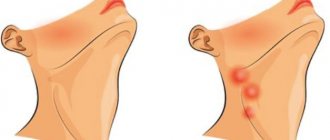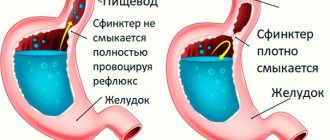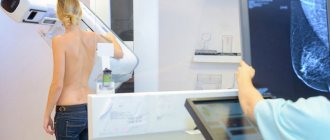To the reference book Enlarged lymph nodes signal the development of an inflammatory pathology in the body or may be a consequence of excessive growth of lymphoid tissues (lymphoproliferative diseases, hyperreactivity of the immune system).
Author:
- Oganesyan Tigran Sergeevich
ENT pathology expert
4.00 (Votes: 10)
Lymph nodes are peripheral organs of the lymphatic system, the main task of which is to provide a natural filter for lymph and the body's immune defense. In the lymph nodes, lymphatic fluid is filtered from microorganisms, atypical cells and other antigenically foreign particles. In this case, an immunological reaction develops, during which the formation and maturation of immune cells that are capable of destroying foreign agents (bacteria, fungi, viruses, parasites, malignant cells, foreign inclusions) occurs.
Enlarged lymph nodes signal the development of an inflammatory pathology in the body or may be a consequence of excessive growth of lymphoid tissues (lymphoproliferative diseases, hyperreactivity of the immune system).
Inflammation of the lymph nodes can be purulent and non-purulent, depending on the duration of the course - acute and chronic. It can be local (when only a certain group of nodes increases) and generalized (inflammation affects several unrelated groups at once).
Depending on their location, all lymph nodes are combined into the following regional groups:
- cervical, widely scattered along the front and side surfaces of the neck;
- mental, located behind the chin;
- occipital, located at the junction of the neck and skull;
- submandibular, lying in the middle of the lower jaw;
- parotid and behind the ear, located in front and behind the ears;
- axillary, one group of which is located in the thickness of the fiber of the axillary region, and the other is adjacent to the inner surface of the pectoral muscles;
- elbow – on the front surface of the elbow joint;
- inguinal, located in the inguinal folds;
- popliteal, localized on the back surface of the knee joints.
Thus, there are quite a lot of areas where enlarged lymph nodes can be detected. Moreover, with different diseases they increase in different ways. The following may differ: consistency, surface structure, mobility, pain on palpation, and the condition of the skin over them. It is very important to diagnose and identify the root cause of the development of the inflammatory process, which only a certified doctor can handle.
1.What are lymph nodes?
Lymph nodes
- These are small glands that resemble beans in shape and are located throughout the human body. Lymph nodes are part of the lymphatic system, through which fluid (lymph), nutrients move, and substances that the body does not need are removed into the bloodstream.
Lymphatic system
– an important part of the immune system that protects the body from disease. Lymph nodes filter lymphatic fluid (lymph) as it passes through them, trapping bacteria, viruses and other harmful and foreign substances, which are then destroyed by lymphocytes - white blood cells.
Lymph nodes can be single or in groups. The size of lymph nodes can range from very small - the size of a pinhead, to quite large - the size of a large grape. Lymph nodes can be felt in the neck, groin and armpits. In general, lymph nodes are usually not noticeable and do not cause pain when pressed on them. Most lymph nodes in the body cannot be felt at all.
A must read! Help with treatment and hospitalization!
Fact #5
Lymph nodes enlarge during cancer because cancer cells enter the lymphatic vessels draining a certain area, which then settle in the “filters” (lymph nodes) in the form of metastases and begin to grow there.
Such lymph nodes do not shrink after treatment of infectious diseases, but only increase, merging with other lymph nodes into conglomerates, extending beyond the lymph node and fixing it in the surrounding tissues. Such lymph nodes are rarely painful, they are dense, very dense.
Often in cancer, lymph nodes are affected by a “chain” that is clearly visible on palpation. With lymphomas, conglomerates are often visible from the outside. Of course, with such manifestations you need to go to an oncologist and hematologist.
For suspicious nodes, a biopsy will be performed in the absence of other causes. This is either a puncture with a needle and collection of material, or an operation to completely remove the lymph node for histological examination.
2. Why does lymph node enlargement occur?
Often, single lymph nodes become painful and swollen due to various injuries, infections, or tumors developing in or near the lymph nodes. Depending on which lymph nodes are inflamed and swollen, the cause of inflammation of the lymph nodes
:
- Swollen lymph nodes in the neck, under the jaw, or behind the ears
usually occur due to a cold or sore throat. Enlarged cervical lymph nodes can occur after injury - a cut or bite near the gland, or due to swelling and infection of the mouth, head and neck; - Inflammation of the lymph nodes under the arm
(axillary lymph nodes) occurs due to injury or infection of the arm. In rare cases, the lymph node under the arm becomes enlarged due to breast cancer or lymphoma; - Lymph nodes in the groin
become inflamed, painful, and enlarged from injury or infection of the leg, groin area, or genitals. In rare cases, the cause of inflammation of the lymph nodes in the groin is testicular cancer, lymphoma or melanoma; - Inflammation of the lymph nodes above the collarbone
(supraclavicular lymph nodes) can occur due to an infection or tumor in the lungs, chest, neck, or abdomen.
Visit our Therapy page
Classification
Acute lymphadenitis is accompanied by pain in the area of the cervical lymph nodes
Regional lymph nodes are classified by location:
- Inguinal: legs, abdominal wall, buttocks.
- Axillary: arms.
- Cervical: head, face, neck.
- Mediastinal: breast (breast).
- Para-aortic: abdominal organs.
According to the clinical course, lymphadenitis is distinguished between acute (up to 4 days) and chronic (4-6 days). Acute inflammation of the upper respiratory tract is usually often accompanied by inflammatory swelling of the cervical lymph nodes. Chronic inflammation of the upper respiratory tract can also cause its enlargement. Inflammation in other organs is less often manifested by enlarged lymph nodes.
Lymphoma is staged according to the Ann Arbor classification. There are 4 stages, which are characterized by varying involvement of lymph nodes and organs outside the system in the malignant process. There are also asymptomatic and symptomatic forms of lymphoma.
3. Diseases leading to inflammation of the lymph nodes
If the lymph nodes become inflamed and enlarged in more than one area of the body, it is called generalized lymphadenopathy.
This inflammation of the lymph nodes is caused by:
- Viral diseases such as measles, rubella, chickenpox or mumps;
- Mononucleosis, the symptoms of which are fever, sore throat, fatigue, as well as the viral infection cytomegalovirus that causes similar symptoms;
- Bacterial diseases such as strep throat (caused by streptococcus bacteria) or Lyme disease (a bacterial infection spread by certain types of ticks);
- Side effects from taking phenytoin, a medicine used to prevent seizures;
- Side effects from the measles-mumps-rubella vaccine;
- Cancer - leukemia, Hodgkin's disease and lymphoma;
- AIDS, acquired immunodeficiency syndrome;
- Syphilis is a sexually transmitted disease.
About our clinic Chistye Prudy metro station Medintercom page!
Diagnostics
First, the doctor collects anamnesis and conducts a thorough physical examination of the patient: examines and palpates enlarged lymph nodes, assesses their size, mobility, and soreness.
If more serious illnesses are suspected, further tests will be carried out:
- radiography;
- ultrasonography;
- Magnetic resonance imaging;
- CT scan;
- positron emission tomography.·
If lymphoma is suspected, the doctor removes the enlarged lymph node and sends it to a pathologist for histological examination. Bone marrow examination is often required to make a correct diagnosis.
For chronic enlarged lymph nodes, the following studies are recommended:
- general blood analysis;
- determination of the concentration of lactate dehydrogenase and uric acid;
- chest x-ray;
- test for tuberculosis (Mantoux reaction).
4.Treatment of lymph nodes
Treatment of swollen lymph nodes involves treating the cause of their enlargement, swelling and pain. For example, a bacterial infection is usually treated with antibiotics, but a viral infection often goes away on its own. A more serious case is cancer. If there is reason to suspect that enlarged lymph nodes are associated with oncology, a biopsy may be performed and, of course, a full examination by a good doctor is necessary.
In any case, if the enlarged lymph nodes do not go away in about a month and their size does not decrease, you should consult a doctor. In general, lymph nodes may remain swollen long after the infection has passed. This is especially common in children.
Development mechanism
Enlargement of lymph nodes occurs in several ways, each of which involves the accumulation of a certain type of cell in the lymphoid tissue. The reaction of peripheral lymphatic organs is often associated with increased blood flow, proliferation of lymphocytes and macrophages in response to the appearance of foreign genes. With antigenic stimulation, the node can increase 5-15 times in 5-10 days. Systemic neoprocesses are characterized by active proliferation of degenerated lymphoid cells with an increase in the size of the affected lymph node.
The stroma of lymphatic formations can be infiltrated by inflammatory elements (in infectious diseases), tumor cells located in the lymphatic drainage zone of a given node. Metastatic lesions are often accompanied by proliferation of connective tissue. In some disorders of lipid metabolism (Niemann-Pick disease, Gaucher syndrome), macrophages filled with undigested glycosphingolipids are retained in the lymph node.
Axillary lymphadenitis in a child
Back diseases and lymphadenitis
Can spinal diseases cause inflammation and enlargement of lymph nodes? There is no direct connection here, but with pathologies of the spinal column, microcirculation in the paravertebral tissues is often disrupted, for example, due to compression of the vessels through which blood and lymph pass. This leads to stagnation of lymph, accumulation of toxins, and the development of inflammation, which causes enlargement of lymph nodes and the appearance of pain.
Damage to the vertebrae and intervertebral discs often causes compression of the lymphatic vessels, which leads to stagnation of lymph and the development of inflammation in the lymph nodes
Such pathologies include, first of all, osteochondrosis, characterized by degenerative changes in the intervertebral discs and vertebrae. Most often, the cervical and lumbar regions are affected, near which there are groups of lymph nodes. With serious tissue damage, the reaction of the lymphatic system is immediately manifested by an increase in nodes, accompanied by inflammation and pain.
Osteochondrosis and inflammation of the lymph nodes
Other pathologies can cause the same reaction:
- Bekhterev's disease;
- spondylitis;
- spondyloarthrosis;
- radiculitis;
- sciatica;
- spinal cancer.
The development of a cancerous tumor in the spine also causes enlargement and inflammation of the lymph nodes
For information: with curvatures (scoliosis, kyphosis), lymphadenitis is usually not observed, unless the disease is complicated by a sharp decrease in immunity and serious disturbances in the functioning of individual organs and systems.
Symptoms
You can determine lymphadenopathy and lymphadenitis yourself only if the superficial lymph nodes are affected - in the neck, armpits or groin. The main signs are the formation of visible tubercles under the skin, dense, painful and mobile to the touch. Their appearance is usually accompanied by fever, general malaise, redness and swelling of adjacent tissues. Sometimes additional problems with breathing, tachycardia, the appearance of a rash in the area of the lump, and skin itching are observed.
How to treat lymph nodes?
For any form of inflammation of the peripheral lymph nodes, you need to drink plenty of fluids
The treatment regimen depends entirely on the diagnosis. Antibiotics should only be prescribed if a bacterial infection is suspected. It is not recommended to use antibiotic drugs unnecessarily.
Important! If the symptoms of a bacterial or viral infection worsen - body temperature rises, lymph nodes become enlarged, chills or severe muscle pain occurs - you should immediately seek medical help. In some cases, the cause may not be an infection, but an aggressive malignant disease.
If the cause of enlarged lymph nodes is a viral infection, symptomatic treatment is recommended. The same applies to Pfeiffer glandular fever (infectious mononucleosis), which usually does not cause complications. Measles and rubella are also recommended to be treated with symptomatic methods.
Numerous sexually transmitted diseases, which can also cause enlarged peripheral lymph nodes, are treated differently: with antibiotics, antiparasitic or symptomatic agents. The lymph nodes shrink as the patient recovers. For tuberculosis, it is necessary to take special anti-tuberculosis drugs.
Lyme disease is not easy to treat because it often affects multiple organs. However, the prognosis at the initial stage is very good.
Diphtheria is a serious disease that often leads to death. Its treatment consists of the use of anti-diphtheria antitoxic serum.
For cancer of the lymph nodes (mostly aggressive non-Hodgkin's lymphoma and Hodgkin's disease), chemotherapy and radiotherapy are used. If necessary, therapy with monoclonal antibodies and cytokine drugs is prescribed. If the above treatment methods are ineffective, high-dose chemotherapy with stem cell transplantation is used.
In any case, enlarged peripheral lymph nodes decrease to normal size only after the patient recovers from the underlying disease.









